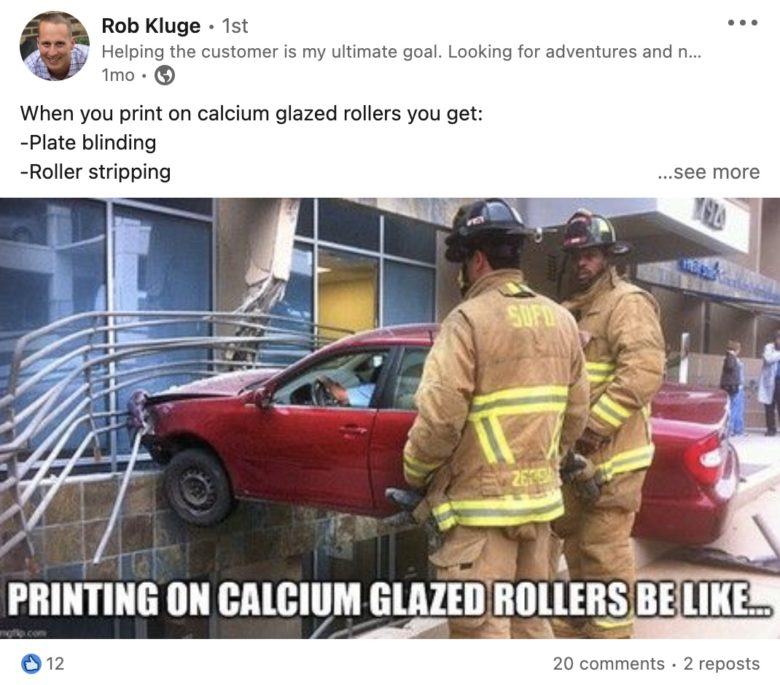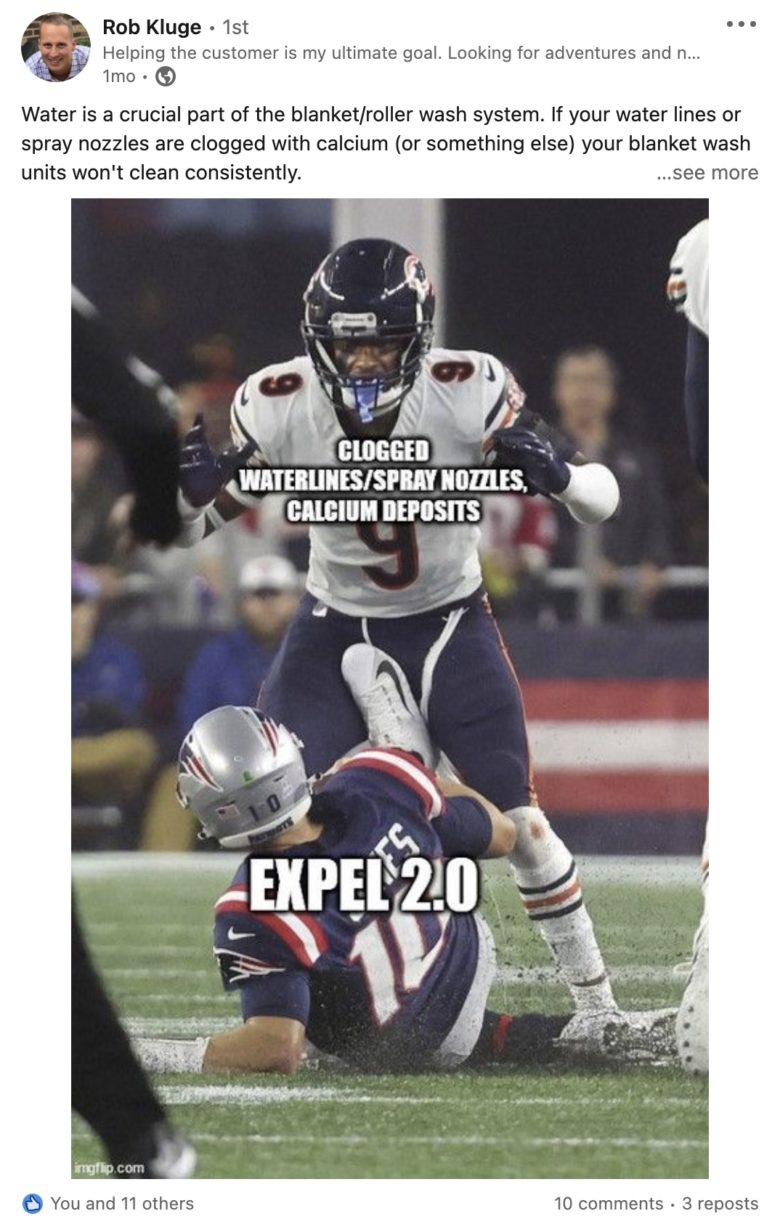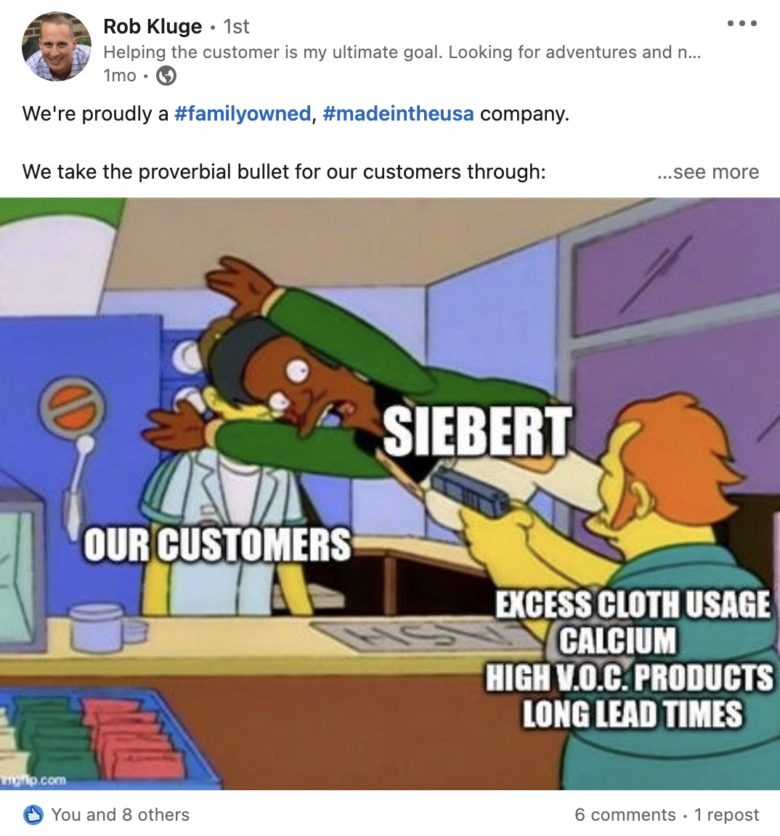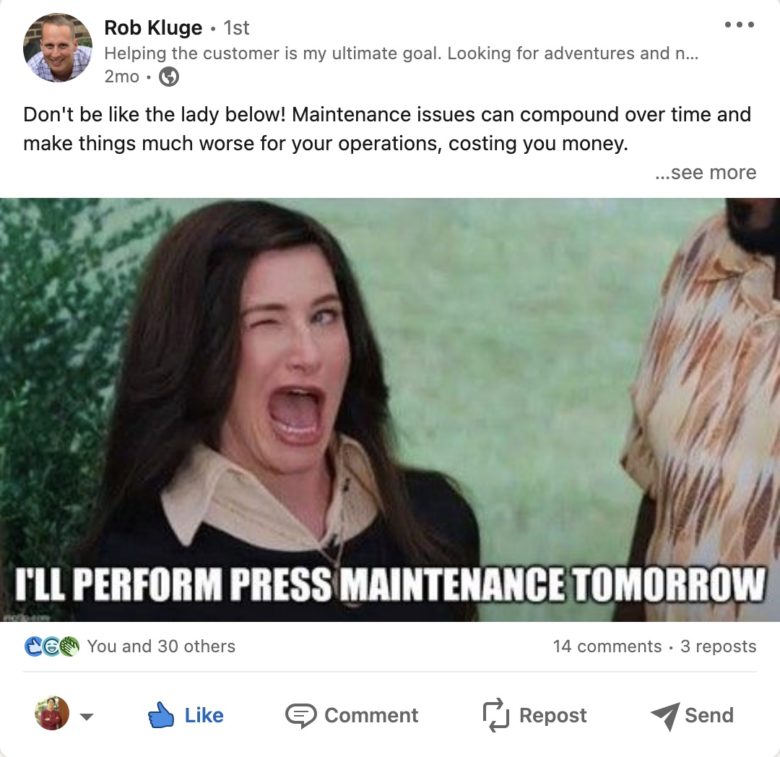
A small, family-owned business, Siebert Inc. manufactures and sells specialized consumables used in the printing industry: automatic blanket wash rolls, calcium eliminators, press washes, replacement bladders – and other products you’ve probably not heard of.
I hadn’t either until I began seeing the company’s very clever posts on LinkedIn. Instead of standard marketing-esque posts (in other words, stuff you scroll right past), Rob Kluge, Siebert’s Customer Service Manager, uses popular memes you often see around the Internet.
Witty and very different, the meme posts have helped Kluge build an audience, as well as significantly increase impressions, engagement, and direct inquiries, for Siebert’s products.

“We’re in a very niche printing consumables business,” says Kluge. “Ten years ago, only two to three companies were selling similar products. We had no need for marketing that got us noticed. That scenario has changed – dramatically.”
Competition is fierce, and includes international players. Even with sales reps and dealers across the United States, Siebert has to work hard to differentiate itself – which it does by delivering a superior product.
But of course, no one will know about your awesome products or services unless you get their attention in an attention-starved world.
Fun + education = memes that get traction
Like many of us, Kluge began posting standard “here’s what we sell” posts on the company’s LinkedIn page.
“If I was lucky, a post would get 100 impressions,” he says. “I was also posting every day, which was exhausting – especially since marketing is a very small part of my job. I quickly learned my milquetoast posts weren’t going to help us build engagement or our customer base.”
Kluge turned to common memes you see on Twitter, Facebook, Reddit, and other forums, plus scenes from popular TV shows and cartoons, such as The Simpsons, and sports. He then customized the memes to state an industry challenge and how a Siebert product solves it.

Other changes included posting from his personal LinkedIn profile versus the company page, and reducing posting frequency to twice a week, while also commenting on or sharing colleagues’ posts.
His efforts began to pay off: Engagement (likes, comments, etc.) increased as did direct inquiries through post comments or DMs.
“Cheap, free, and fun”
Being a small company with nine employees, Kluge’s marketing budget is tight. He keeps costs low by doing everything in-house.
“You find ways to save money,” he says. For example, Kluge keeps a running list of memes and/or ideas he finds while consuming other content. He creates his memes using Microsoft Paint and imgflip.com to add the text boxes. He recently started using Veed (a free video editing software) to create custom gifs.
His goal is to be funny and informative, and to trigger nostalgia. “I want people to think, ‘I remember that TV show from 10 years ago.’ They see the image in their head, now I can tell them about my product.”

Posting consistently each week also has benefits. As of this writing, China is experiencing another lockdown (creating a labor shortage) and ocean freight is fraught with delays and outright cancellation of shipments. These issues add to the cost of importing materials from overseas. Many of Siebert’s competitors manufacture their products outside the USA (specifically in China).
Because Siebert makes all their product in the United States, they’re able to fulfill orders. Kluge confirms that while their product costs more up front, it’s also of very high quality and solves many of the printing industry’s challenges – while saving printers significant time, reducing waste, increasing output and therefore making them more money.
“We also provide the best customer service!” he says. He should know, as he’s the person you’ll speak with if you call Customer Service.

In business for over 40 years, Siebert is family-owned and operated and located in Lemont, IL. To learn more about the company and its products, visit: www.siebertinc.com.
You can also follow or connect with Rob Kluge on LinkedIn.
Get the Keep It Made USA newsletter.
Twice monthly; zero spam.
Full Disclosure
I’m not paid nor asked to write about products or the companies that make them. All links in this piece are FREE — meaning, they’re not sponsored or paid for. I buy products, use them, and if I like them, I tell everyone about them.
I do this because my mission with this blog to help people understand the importance of buying Made in USA – whether B2B or consumer – in order to keep manufacturing jobs stateside. This mission is my way of giving back. We like to think our “small” choices won’t make a difference. They do.
